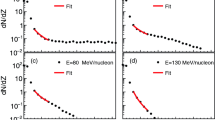Abstract
The properties of the strong fluctuations observed in the excitation functions of Dissipative Binary Heavy Ion Collisions (DBHIC) have been studied for the system28Si+28Si in the energy range 150 MeV ≤E lab ≤ 156 MeV with 150 keV step laboratory incident energy, by angular distributions and excitation functions measurements. Experimental results are compared to the the recently developed Partially Overlapping Molecular Level Model (POMLM). The parameters of the model have been determined with reasonable accuracy by describing all the quantities characterizing the fluctuations in the excitation functions i.e.: Average Angular Distributions, Energy Autocorrelation Functions, Variances, Angular Correlation Coefficients. The results of the analysis strongly support the idea of a process proceeding through the formation of an highly excited “nuclear molecule”. Experimental data collected at the most forward angles show the effects of strong excitation of a few final channels.
Similar content being viewed by others
References
Ericson T.,: Ann.Phys23, 390 (1963).
De Rosa A., Inglima G., Russo V., Sandoli M., Fortuna G., Montagnoli G., Signorini C., Stefanini A.M., Cardella G., Pappalardo G., and Rizzo F.: Phys. Lett160B, 239 (1985).
Pappalardo G.: Nucl. Phys. A488, 395c. (1988)
Suomijarvi T., Berthier B., Lucas R., Mermaz M.C., Coffin P., Guillaume G., Hensch B., Jundt F., and Rami F.: Phys.Rev.C36, 181 (1987).
Cardella G., Papa M., Pappalardo G., Rizzo F., De Rosa A., Inglima G., and Sandoli M.: Z.Phys.A332, 195 (1989).
De Rosa A., Fioretto E., Inglima G., Romoli M., Sandoli M., Cardella G., Papa M., Rizzo F., Napoli D.R., Stefanini A.M., and Signorini C.: Phys. Rev.C44, 747 (1991).
Cardella G., Papa M., Pappalardo G., Rizzo F., Wang Q., De Rosa A., Fioretto E., Inglima G., Romoli M., Sandoli M., Setola R., Corradi L., Montagnoli G., Napoli D.R. and Stefanini A.M.: Z.Phys.A336, 387 (1990).
De Rosa A., Inglima G., Russo V., and Sandoli M.: Nuovo Cimento58A, 254 (1980).
Mermaz M.C., Suomijarvi T., Lucas R., Berthier B., Matuszec J., Coffin J.P., Guillaume G., Hensch B., Jundt F., and Rami F.: Nucl.Phys. A456, 186 (1986).
Pappalardo G. and Papa M.: Proc. of Workshop on Multistep Direc Reaction NAC FAURE S.A. 30 sep. 1991 ed RH.Lemmer World Scientific pag. 89.
Papa M.: Ph.D. Thesis, VI Cycle, Catania University 1994.
Brink D.M. and Dietrich K.Z.: Z.Phys.A326, 7 (1987).
Kun S.Yu., Papa M., and Sunko D.K.: Phys.Lett.B249, 1 (1990).
Kun S.Yu.: Phys.Lett.B257, 247 (1991).
Kun S.Yu. and Nörenberg W.: Z.Phys.A343, 215 (1992).
Kun S.Yu, Nörenberg W. and Papa M.: Phys.Lett.B298, 273 (1993).
S.Yu. Kun, Papa M., and Robson A.B.: Z.Phys.A347, 123 (1993).
Rizzo F., Cardella G., De Rosa A., Di Pietro A., D'Onofrio A., Fioretto E., Inglima G., Musumarra A., Papa M., Pappalardo G., Romano M., Romoli M., Terrasi F., Sandoli M., Wang G.S.: Z.Phys.A349 169 (1994).
Cindro N.: Ann. Phys. 13, 289 (1988).
Abbondanno U.: Phys. Rev.C43, 1484 (1991).
Betts R.R., Back B.B. and Glacola B.G.: Phys.Rev.Lett.47, 23 (1981).
Betts R.R., DiCenzo S.B. and Peterson J.F.: Phys.Lett.100b, 117 (1981).
Uegaki E., Abe Y.: Phys.Lett.B340, 143 (1994).
Kun S.Yu.: Proc. of the 7th Int. Conf. on Nuclear Reaction Mechanism, Varenna, June 1994, ed. E.Gadioli
Author information
Authors and Affiliations
Additional information
Communicated by X. Campi
Thanks are due to Mr. C.Marchetta for the high quality targets and to Mr. V.Campagna and Mr. S. Salomone for the help in the detector assembly. We thank also the whole staff of the Tandem for the beam quality.
Rights and permissions
About this article
Cite this article
Papa, M., Cardella, G., Di Pietro, A. et al. Highly excited “nuclear molecules”: A way to explain the fluctuations in DBHIC excitation functions. Study of the28Si +28Si colliding system at 5.3 MeV ·A. Z. Physik A - Hadrons and Nuclei 353, 205–212 (1995). https://doi.org/10.1007/BF01295899
Received:
Issue Date:
DOI: https://doi.org/10.1007/BF01295899




